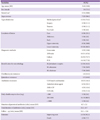1. Griffith DE, Aksamit T, Brown-Elliott BA, Catanzaro A, Daley C, Gordin F, Holland SM, Horsburgh R, Huitt G, Iademarco MF, Iseman M, Olivier K, Ruoss S, von Reyn CF, Wallace RJ Jr, Winthrop K. An official ATS/IDSA statement: diagnosis, treatment, and prevention of nontuberculous mycobacterial diseases. Am J Respir Crit Care Med. 2007. 175:367–416.

2. Choi GE, Jo YS, Shin SJ. Current Understanding of Mycobacterium abscessus Infection. J Bacteriol Virol. 2012. 42:17–28.

3. Hoffman PC, Fraser DW, Robicsek F, O'Bar PR, Mauney CU. Two outbreaks of sternal wound infection due to organisms of the Mycobacterium fortuitum complex. J Infect Dis. 1981. 143:533–542.

4. Kuritsky JN, Bullen MG, Broome CV, Silcox VA, Good RC, Wallace RJ Jr. Sternal wound infections and endocarditis due to organisms of the Mycobacterium fortuitum complex. Ann Intern Med. 1983. 98:938–939.

5. Wallace RJ Jr, Swenson JM, Silcox VA, Good RC, Tschen JA, Stone MS. Spectrum of disease due to rapidly growing mycobacteria. Rev Infect Dis. 1983. 5:657–679.

6. Wallace RJ Jr, Brown BA, Onyi GO. Skin, soft tissue, and bone infections due to Mycobacterium chelonae: importance of prior corticosteroid therapy, frequency of disseminated infections, and resistance to oral antimicrobials other than clarithromycin. J Infect Dis. 1992. 166:405–412.

7. Yang HY. Isolation Trend of Nontuberculosis Mycobacteria at a Tertiary-care Hospital in 2003-2011. Kosin Med J. 2011. 26:155–160.
8. Lee SK, Lee EJ, Kim SK, Chang J, Jeong SH, Kang YA. Changing epidemiology of nontuberculous mycobacterial lung disease in South Korea. Scand J Infect Dis. 2012. 44:733–738.

9. Lim JM, Kim JH, Yang HJ. Management of Infections with Rapidly Growing Mycobacteria after Unexpected Complications of Skin and Subcutaneous Surgical Procedures. Arch Plast Surg. 2012. 39:18–24.

10. Jo KU, Park SJ, Hong SC, Oh YM, Lee SD, Kim WS, Kim DS, Kim WD, Shim TS. Long-term Outcome of Treatment of Mycobacterium abscessus Pulmonary Disease. Tuberc Respir Dis. 2007. 62:98–104.

11. Kim HY, Yun JY, Park CG, Lee DH, Cho YK, Park BJ, Joo SI, Kim EC, Hur YJ, Kim BJ, Kook YH. Outbreak of Mycobacterium massiliense Infection Associated with Intramuscular Injections. J Clin Microbiol. 2007. 3127–3130.
12. Song JY, Sohn JW, Jeong HW, Cheong HJ, Kim WJ, Kim MJ. An outbreak of post-acupuncture cutaneous infection due to Mycobacterium abscessus. BMC Infect Dis. 2006. 6:6.

13. Lee WJ, Kang SM, Sung H, Won CH, Chang SE, Lee MW, Kim MN, Choi JH, Moon KC. Non-tuberculous mycobacterial infections of the skin: a retrospective study of 29 cases. J Dermatol. 2010. 37:965–972.

14. Lee SH, Kim KY, Hong SP, Kim MJ, Yang MH, Seou JT. A Mycobacterium chelonae Subsp. abscessus Wound Infection After Percutaneous Endoscopic Gastrostomy. Korean J Med. 1997. 53:842–846.
15. Kim YJ, Choi YW, Choi HY, Myung KB. A Case of Subcutaneous Abscess with Mycobacteria chelonae Infection. Korean J Dermatol. 1999. 37:1777–1781.
16. Park YM, Kang H, Cho SH, Cho BK, Kim BJ, Kook YH, Park EM. A case of Scrofuloderma Caused by Mycobacterium fortuitum. Korean J Infect Dis. 1999. 31:171–175.
17. Han HJ, Kang KS, Lee BH, Park CW, Lee CH, Yoo CW. A Case of Cutaneous Infection with Mycobacterium Chelonae. Korean J Dermatol. 2004. 42:320–323.
18. Kim JH, Choe WH, Kang JO, Choi TY. Five Cases of Mycobacterium abscessus. Korean J Clin Microbiol. 2004. 7:84–89.
19. Bae JM, Kim MY, Park YM, Kim HO. A case of Mycobacteria chelonae Infection after Ingection of Filler. Korean J Dermatol. 2006. 44:59–62.
20. Kim HS, Park HJ, Lee JY, Cho BK. Mycobacterium fortuitum Infection Caused by a Nerve Block. Ann Dermatol. 2007. 19:9–12.

21. Park DW, Kim JE, Back SY, Park HS, Son CN, Ahn SE, Park HJ, Jang SH, Paik SS, Choi CH, Choi TY, Pai HJ. Post-traumatic Infrapatellar Bursitis due to Mycobacterium fortuitum in an Immunocompetent Patient. Infect Chemother. 2008. 40:292–296.

22. Choi YJ, Lee HJ, Lee KY, Ryu DJ, Lee MG. A Case of Mycobacterium fortuitum Infection at the Site of Acupuncture. Korean J Dermatol. 2009. 47:755–758.
23. Kim WJ, Shin KH, Hwang JM, Kim KH, Choi HK, Lee SH, Lee SJ. Knee Joint Osteomyelitis due to Mycobacterium abscessus: A Case Report. Infect Chemother. 2010. 42:315–318.

24. Shim WH, Park HJ, Kim HS, Chin HW, Kim SH, Ko HC, Kim BS, Kim MB, Kwon KS. Mybacterium chelonae Infection Occurring at the Site of Bee Sting Therapy. Korean J Dermatol. 2011. 49:374–378.
25. Yang HJ, Yim HW, Lee MY, Ko KS, Yoon HJ. Mycobacterium conceptionense infection complicating face rejuvenation with fat grafting. J Med Microbiol. 2011. 60:371–374.

26. Kang YS, Kim HS, Park YM, Kim HO, Park YJ, Lee JY. Mycobacterium fortuitum Infection after Footbath. Korean J Dermatol. 2012. 50:56–59.
27. Kim M, Sung YB, Kim BN. Skin and Soft Tissue Infection Caused by Mycobacterium abscessus Developed after Intramuscular Injection: A Case Report. Infect Chemother. 2012. 44:67–70.

28. Hsiao CH, Tsai TF, Hsueh PR. Characteristics of skin and soft tissue infection caused by non-tuberculous mycobacteria in Taiwan. Int J Tuberc Lung Dis. 2011. 15:811–817.

29. Chen HY, Chen CY, Huang CT, Ruan SY, Chou CH, Lai CC, Liao CH, Tan CK, Huang YT, Yu CJ, Hsueh PR. Skin and soft-tissue infection caused by non-tuberculous mycobacteria in Taiwan, 1997-2008. Epidemiol Infect. 2011. 139:121–129.

30. Eid AJ, Berbari EF, Sia IG, Wengenack NL, Osmon DR, Razonable RR. Prosthetic joint infection due to rapidly growing mycobacteria: report of 8 cases and review of the literature. Clin Infect Dis. 2007. 45:687–694.

31. National Institute of Meteorological research. Understanding of Climate Change VI - climate variability in Jeju province. 2010. Jeju: NIMR;1–63.
32. Korean Society of Infectious Diseases. Infectious Diseases. 2009. 2nd ed. Seoul: Koonja;563–569.
33. Han XY. Seasonality of clinical isolation of rapidly growing mycobacteria. Epidemiol Infect. 2008. 136:1188–1191.









 PDF
PDF ePub
ePub Citation
Citation Print
Print




 XML Download
XML Download